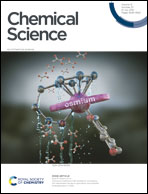High-yield and sustainable synthesis of quinoidal compounds assisted by keto–enol tautomerism†
Abstract
The classical synthesis of quinoids, which involves Takahashi coupling and subsequent oxidation, often gives only low to medium yields. Herein, we disclose the keto–enol-tautomerism-assisted spontaneous air oxidation of the coupling products to quinoids. This allows for the synthesis of various indandione-terminated quinoids in high isolated yields (85–95%). The origin of the high yield and the mechanism of the spontaneous air oxidation were ascertained by experiments and theoretical calculations. All the quinoidal compounds displayed unipolar n-type transport behavior, and single crystal field-effect transistors based on the micro-wires of a representative quinoid delivered an electron mobility of up to 0.53 cm2 V−1 s−1, showing the potential of this type of quinoid as an organic semiconductor.



 Please wait while we load your content...
Please wait while we load your content...